Lijssenthoek Military Cemetery, Poperinge, Ypres Salient Battlefields, Belgium
Lijssenthoek Military Cemetery is the resting place of 10,755 casualties of the First World War. It is the second largest British and Commonwealth cemetery in Belgium.
- Casualties
- Origins
- Staff Nurse Nellie Spindler
- The Lijssenthoek Project
- The Lijssenthoek Visitor Centre
Casualties
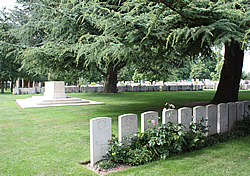
|
The number of burials at Lijssenthoek is, nevertheless, just over a thousand fewer than the largest British cemetery in Belgium, and indeed the whole world, at Tyne Cot Cemetery near Passchendaele. Tyne Cot contains 11,954 burials in its cemetery. Whilst the two cemeteries are almost the same size there is one essential difference between them and this is regarding the number of identified burials there. At Tyne Cot the vast majority of the burials (approximately 70%) are unidentified. At Lijssenthoek, however, almost all the casualties buried here are identified.
Of the total burials there are 9,901 members of the Commonwealth Forces buried in Lijssenthoek cemetery, 24 of whom are unidentified. 883 of the graves are for other nationalities, most of these being French and German burials. One burial in the cemetery is a non World War burial. There is one U.S. Army burial.
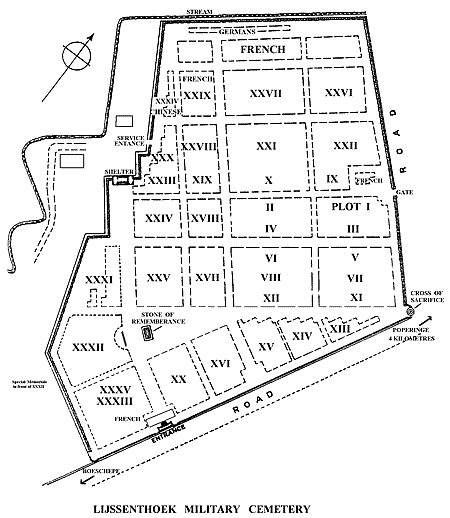
|
All but 41 of the burials were for casualties who died while being treated at the medical facilities here during the period 1914-1919. The 41 burials brought to the cemetery after the war included: 24 burials reinterred in 1920 (to Plot XXXI), having been brought into the cemetery from isolated burial sites near to Poperinge and 17 burials reinterred in 1981 (to Plot XXXII) from St. Denijs Churchyard.
Eight headstones located near to the Stone of Remembrance bear the inscription to men who are believed to be buried in the cemetery.
The cemetery was designed by Sir Reginald Blomfield.
The Origins of Lijssenthoek Military Cemetery
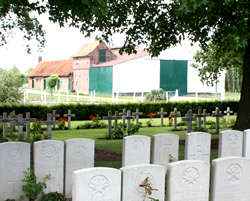
|
The cemetery was started by the French 15th Hôpital d'Evacuation in the early months of the war between autumn 1914 and early summer 1915. At this time French military forces were present in the Ypres Salient, holding the Allied Front Line positions to the north and to the south-east of the city of Ypres.
Lijssenthoek was a small village located south of the town of Poperinghe. Being some 20 kilometres from Ypres it was far enough away from the battlefields of the Ypres Salient to be out of range of the German long-range artillery. For the Allied Forces Lijssenthoek was in a good strategic position to set up a medical centre for treating wounded from the Ypres Salient battlefields because it was located next to the railway line which ran between Poperinghe and Hazebrouck in France. This line provided a direct connection as a main communication route between the British-held battle lines at Ypres and the Allied rear areas, including the coastal port of Boulogne, where the British Base Hospitals were established.

|
A farm called Remi Quaghebeur was the focal point for the location of the British field hospital here. On the British Army trench map illustrated here it was named Corfu Farm. Marked on the map as “Hospital” the Casualty Clearing Stations were established around the farm and the huts can be seen marked in blue. Sidings, known as Remi Sidings, were constructed from the main railway line to enable ambulance trains to bring wounded into these medical stations from Poperinge and to take them from there on to the Base Hospitals as necessary. Four Casualty Clearing Stations were located here by 1917, spread across a wide expanse of ground. The size of the medical facility as it grew in size reflected the scale of the injuries and number of casualties being brought back from the Front Lines as major offensives were carried out. The dates on the graves of many of the casualties buried in the cemetery are also testament to the wounds received by men serving in and around the Front Lines even during quieter times in the Ypres Salient. The cemetery is marked on the map illustrated here with a light brown shading.
From June 1915 the cemetery began to be used for British and Commonwealth casualties who did not survive their wounds, having been treated at Lijssenthoek by the British casualty clearing stations of the Commonwealth forces. The reason why almost all the burials in this cemetery are identified is because they were being treated for their wounds and would therefore have been evacuated from the Front Line area wearing their identity tags, plus they would have likely had some personal possessions in their pockets.
In the period of the German advance following the great German Spring Offensive of 1918, the casualty clearing stations based at Lijssenhoek were evacuated between April and August 1918. During this time the medical facility was still operating for the Allied wounded but with field ambulance units (including one French ambulance), which were mobile and could move out of the position more quickly if necessary.
Staff Nurse Nellie Spindler
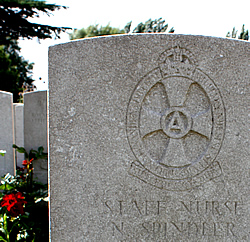
|
Nellie Spindler was a member of Queen Alexandra's Imperial Military Nursing Service. In August 1917, during the first three weeks of the Third Battle of Ypres she was serving as a nurse with 44th Casualty Clearing Station (CCS) at Brandhoek, five kilometres east of Poperinghe. On 21 August 1917 the CCS at Brandhoek was hit by German artillery shells. Five nurses including Nellie were concussed by the explosions. Nellie died later in hospital from an injury to her chest. Her body was brought to the cemetery at Lijssenthoek for burial. Over one hundred officers, four generals and the Surgeon-General attended the funeral.
She was aged 26 and the daughter of George and Elizabeth Spindler from Wakefield, Yorkshire. Nellie is one of only two British female casualties of the First World War to be buried in Belgium. The grave reference is Plot XVI, Row A, grave 3. From the main entrance turn immediately right and follow the southern cemetery boundary for about a hundred metres. The grave is in Row A, the row closest to the cemetery boundary.
Graves for Non-British and Non-Commonwealth Casualties
Chinese Labour Corps
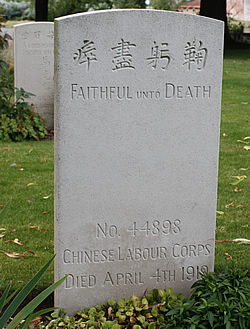
|
Lijssenthoek Military Cemetery contains a number of graves for workers with the Chinese Labour Corps who died in the area of Ypres and Poperinghe during and after the First World War. The Chinese Labour Corps was used to clear battlefields, dig graves, trenches and carry out other such tasks which were often difficult and dangerous.
French Army
French casualties are buried in two plots at the northern end of the cemetery and in Plots XXXV and XXXIII to the left of the main entrance.
German Army
Many German soldiers were treated at the British Casualty Clearing Stations at Lijssenthoek. A number of German headstones in Plot XX along the southern boundary of the cemetery (to the right of the main entrance) mark the final resting place of one or more burials per grave.
United States Army
One grave near to the Stone of Remembrance marks the burial of one soldier of the United States Army.
The Lijssenthoek Project
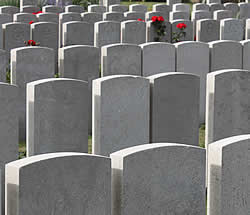
|
A major project was started in June 2009 to establish a new Visitor Centre and archive at the site of the Lijssenthoek Military Cemetery. An integral part of the Visitor Centre is the search for information about the casualties buried in this cemetery. If you have a relative or information about a casualty, the Lijssenthoek Project will be very pleased to hear from you. For more information and contact details see our page at:
The Lijssenthoek Visitor Centre
See our page for information and link to the Visitor Centre.
The Lijssenthoek Visitor Centre
Commonwealth War Graves Commission Plant Nursery
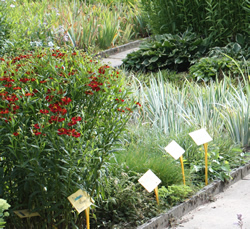
|
Lijssenthoek is one of the locations where the Commonwealth War Graves Commission has a nursery for growing the plants which are so carefully tended and beautifully landscaped in the British and Commonwealth military cemeteries in this area of Belgium.
Location of Lijssenthoek Military Cemetery
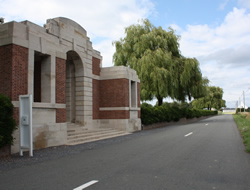
|
Lijssenthoek Military Cemetery, Boescheepseweg, 8970 Poperinge, Belgium
Latitude 50.828289; Longitude 2.701469
Lijssenthoek Military Cemetery is signposted from the N38 (Frans-Vlaanderenweg) road. This road runs between the French-numbered D948 road from Callicannes on the French-Belgian border, where it becomes the Belgian-numbered road N38 to Poperinge. The cemetery lies on the east side of the N38.
Following directions at the green Commonwealth War Graves Commission signpost, turn off the N38 take the side road for about 200 metres. Turn right into Boescheepseweg and continue for approximately 1.5 kilometres. This is a narrow road and care should be taken when getting in and out of vehicles as passing traffic is infrequent but may be fast.
For larger vehicles, such as tour coaches and minibuses, it is not easy to turn around at the cemetery. The N38 can be rejoined again by continuing southwards along the Boescheepseweg for approximately 1.5 kilometres. Take the first right turn into the lane called Lyssenthoek and the N38 will be reached within 1 kilometre.
Access for Disabled Visitors
Disabled visitors and wheelchairs may enter and exit the cemetery from a gate on the eastern side of the cemetery boundary.
Related Topics
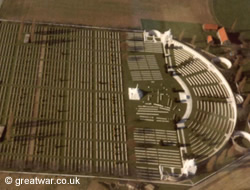
|
Look at some of our pages about the graves and places of commemoration for casualties in the Ypres Salient battlefield areas:
Tyne Cot Cemetery, Zonnebeke, Ypres Salient
Cemeteries in the Ypres Salient
Monuments and Memorials in the Ypres Salient
Acknowledgements
Some of the cemetery description and history has been sourced by kind permission of The Commonwealth War Graves Commission (CWGC). For more information about the cemeteries and the work of the commission visit the CWGC website:
Website: www.cwgc.org
